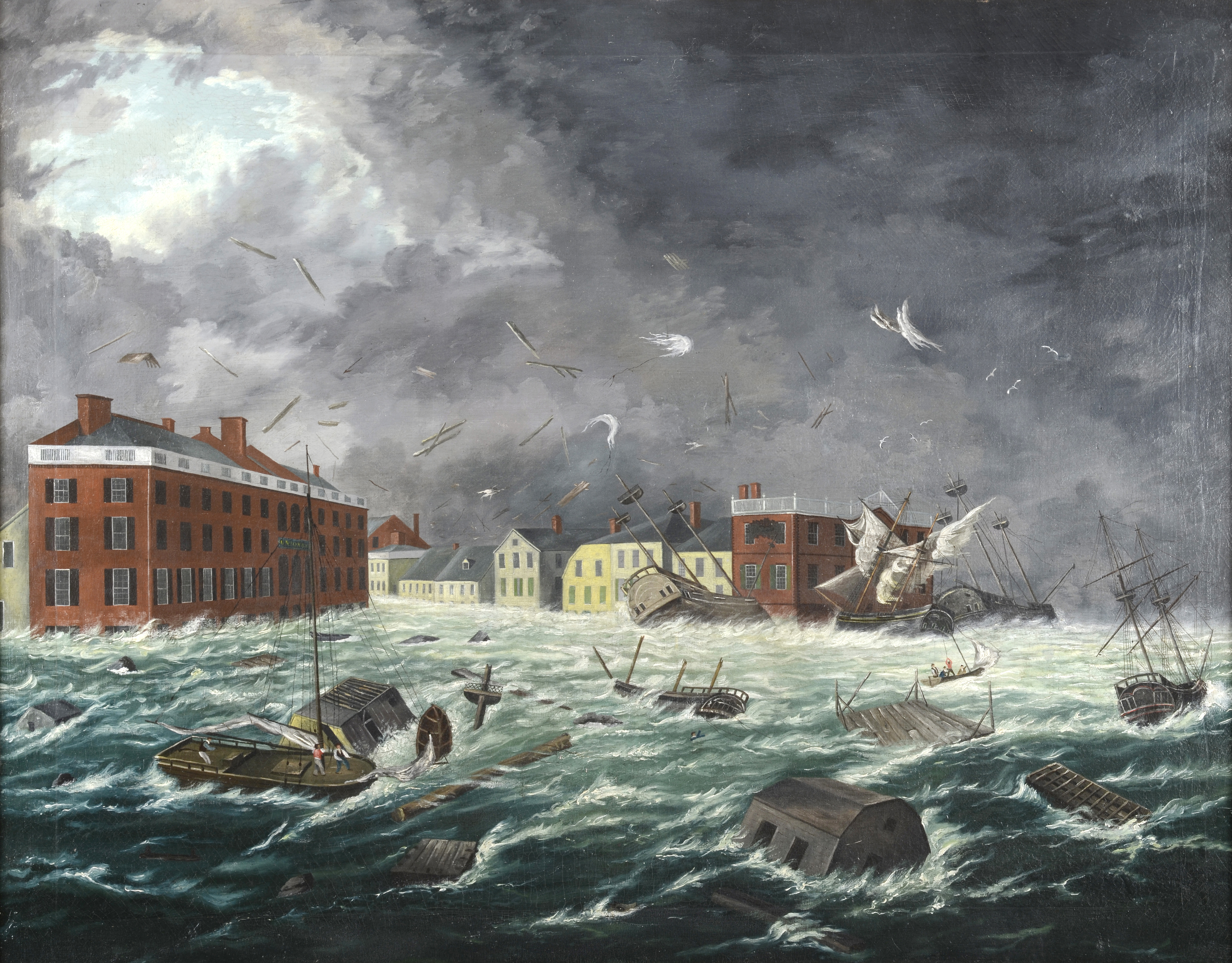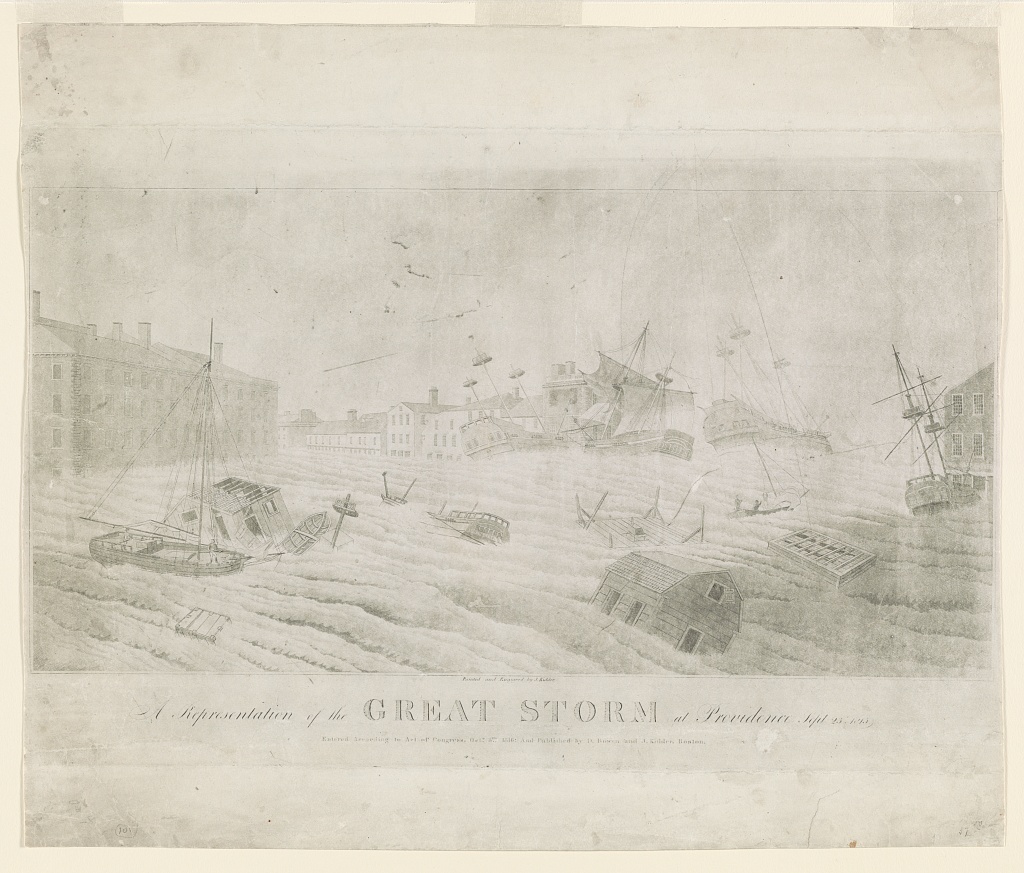The Great September Gale of 1815 by John Russell Bartlett (Rhix5262)
Recently, we have been reminded of our own vulnerability by the rapid spread of COVID-19. Two-hundred and five years ago, Rhode Islanders learned the same lesson from the Great September Gale of 1815. Perhaps the population wished to quietly recover from the ruin of that chastisement, because the gale received very little press. It was, however, dramatically rendered by several pieces of art. One of these — the work of Providence local John Russell Bartlett (1805-1886), who made a name for himself as a businessman, an author, and a scholar — hangs in the library office of the Rhode Island Historical Society.
On the morning of September 23rd, 1815, a powerful hurricane directly struck the coast of southern New England, adding all its strength to a nor’easter which had beleaguered the region for the entirety of the preceding night. A southeasterly wind, with gusts of up to 156 mph, swelled the waters of the Narragansett Bay to an unprecedented height. The storm surge carried ships, houses, and every sort of flotsam as it came. By noon, the weather had abated. Although it had damaged communities all along the coast of southern New England, nowhere was the chaos and destruction as great as in Providence. The Weybossett Bridge was washed away, some five-hundred structures were shattered, and approximately a quarter of the city’s taxable value was lost. There were two fatalities, both at India Point, the area hardest hit and until then the most prosperous.
Bartlett closely modeled his painting after James Kidder’s A Representation of the Great Storm at Providence, Sept. 23rd 1815. Kidder (1793-1837) had sketched the event as he looked down Westminster Street from across the Providence River. None of the pictured premises are still standing today. The rightmost building in Kidder’s work is the Exchange Coffee House; second to the right, at the head of Westminster, is the Washington Insurance Company (where the Hospital Trust Building is now located). Its third-story was left with a gaping hole when the deluge drove the bowsprit of the Ganges into it. The ship continued its unprecedented voyage all the way to the bottom of Smith Hill.
It is probable that Kidder witnessed the flood from an upper window of the Brick Market House. There are two plaques on an outside wall of that historic building. The first marks the waterline of the Great September Gale of 1815: “eleven feet nine and one fourth inches above mean high water.” The second marks the waterline of the Hurricane of September 21, 1938: thirteen feet eight and one half inches. Nature’s lesson was taught again. The wisest course is not to deny its power, but to adapt and prepare. Accordingly, in the 1960s the city constructed the Fox Point Hurricane Barrier. Since then, it has so consistently kept Providence’s downtown free of major flooding that we tend to forget what could happen if it were not there.
-John Shamgochian, 2020 Studio Arts Intern in the RIHS Collections Department.
Sources:
- Bourcier, Paul G. “Prosperity at the Wharves: Providence Shipping, 1780-1850.” Rhode Island History 48(2) 1990, pp. 35-49.
- Emlen, Robert P. “The Great Gale of 1815: Artifactual Evidence of Rhode Island’s First Hurricane.” Rhode Island History 48(2) 1990, pp. 51-61.
- Bartlett, John Russell. “John Russell Bartlett Papers.” Lori Salotto, ed. The Rhode Island Historical Society MSS 286.
- Goodyear, Frank H. American Paintings in the Rhode Island Historical Society. Providence: Rhode Island Historical Society 1974.
- Townsend, William H. “William H. Townsend Papers.” The Rhode Island Historical Society MSS 761, Vol, 1.
- Cavanaugh, Ray. “Providence besieged by Great Gale in 1815.” Providence Journal 2015.
- “The Great September Gale of 1815.” New England Historical Society 2019.
- “Remembering Providence’s Hurricanes.” Joukowsky Institute for Archaeology.


